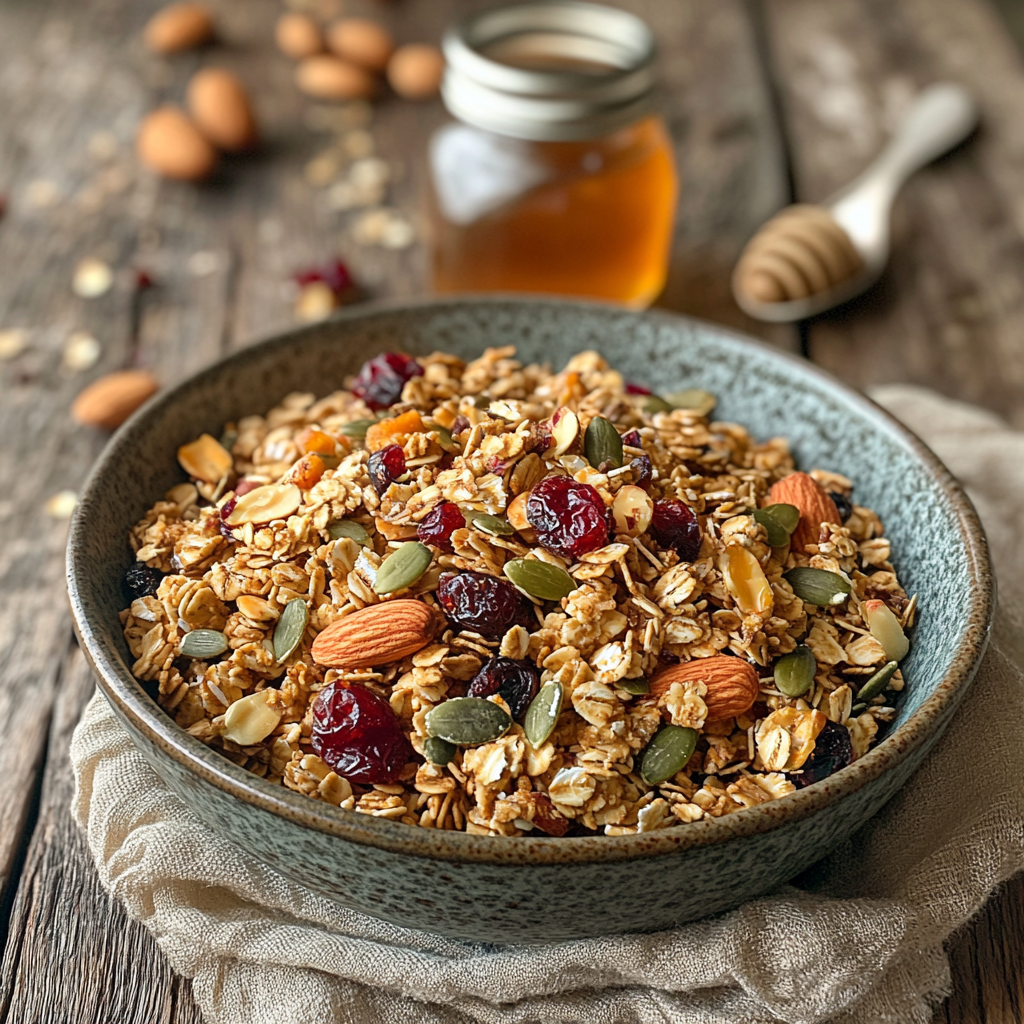Granola is a popular breakfast staple, celebrated for its crunch, versatility, and nutritious composition. Nevertheless, for individuals adhering to a gluten-free diet, finding the right granola can be a challenge. Therefore, this guide delves into everything you need to know about it, from its benefits to how you can make or choose the best options.
Introduction
Gluten-free granola is a variation of traditional granola designed to meet the dietary needs of those who avoid gluten. Made with gluten-free oats and a variety of wholesome ingredients like nuts, seeds, and dried fruits, it’s a delicious option for anyone seeking a healthier alternative.
But why, you might wonder, is gluten-free granola so important? For instance, individuals with celiac disease or gluten sensitivities must avoid gluten to prevent adverse reactions. In addition, many people choose gluten-free products as part of a healthier lifestyle, making it a top choice for breakfast or snacks.
Over the past decade, the demand for gluten-free products has surged, and granola is no exception. As a result, there are now numerous options available in stores, as well as simple recipes for homemade versions. Thus, gluten-free granola has become a versatile and accessible food choice for many individuals.
Understanding Gluten-Free Diets
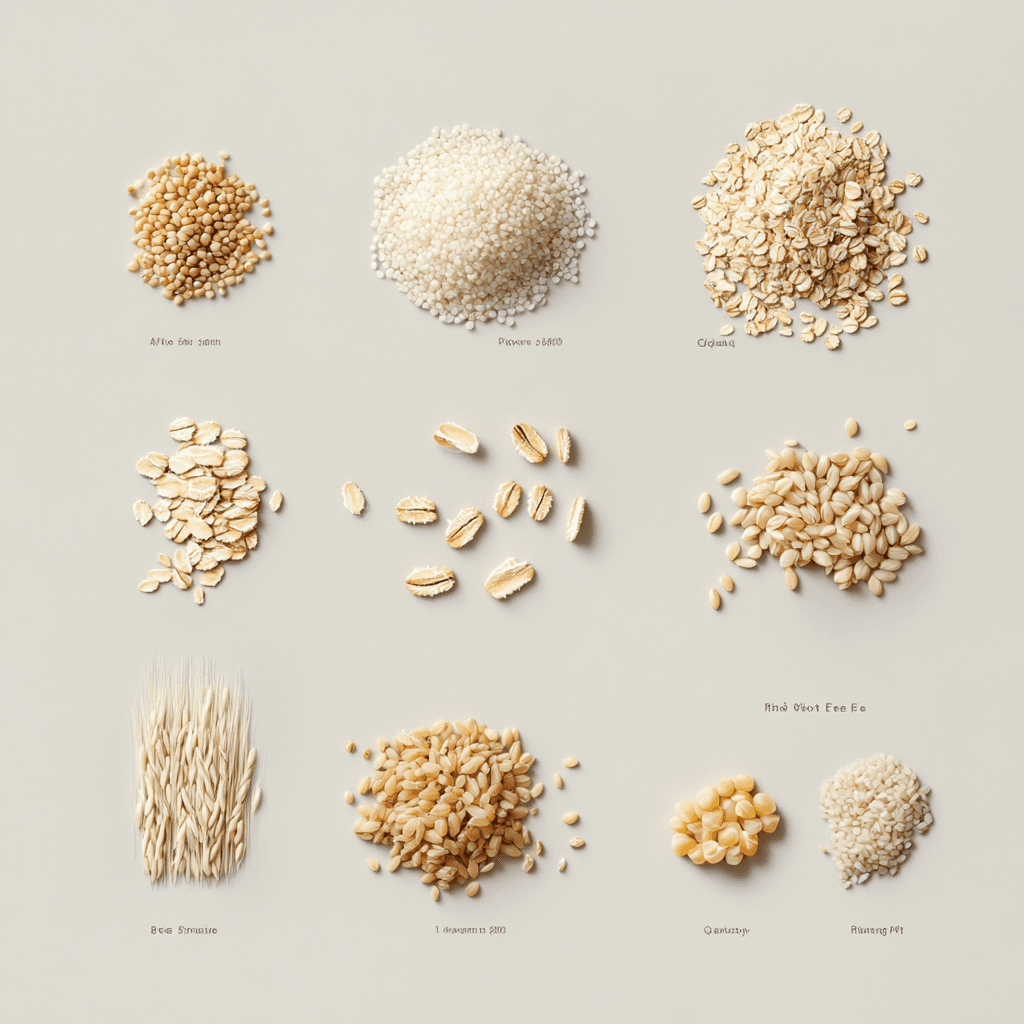
What Is Gluten?
Gluten is a group of proteins found in wheat, barley, rye, and other related grains. It acts as a binder, giving dough its elasticity and helping baked goods maintain their shape. While gluten is harmless to most, it can cause severe reactions in some individuals.
For people with celiac disease, gluten triggers an immune response that damages the lining of the small intestine, leading to nutrient malabsorption and various health issues. Others, who have non-celiac gluten sensitivity, may experience symptoms like bloating, headaches, and fatigue after consuming gluten.
Why Avoid Gluten?
Avoiding gluten is essential for those diagnosed with celiac disease or gluten sensitivity. However, even individuals without these conditions are increasingly exploring gluten-free diets. The potential benefits of avoiding gluten include:
- Improved digestion: Many report fewer digestive issues like bloating and gas.
- Reduced inflammation: Gluten-free diets may help manage inflammation in some cases.
- Boosted energy: Eliminating gluten can lead to increased energy levels for those sensitive to it.
Who Benefits From Gluten-Free Granola?
Gluten-free granola is an excellent choice for:
- Celiac disease sufferers: Safe and delicious, it provides a nutritious alternative.
- Individuals with gluten sensitivities: Enjoy granola without triggering discomfort.
- Health-conscious eaters: Many gluten-free granolas are made with wholesome, unprocessed ingredients, appealing to those seeking a cleaner diet.
- Vegans and vegetarians: Gluten-free granolas often feature plant-based ingredients like nuts, seeds, and dried fruits, making them an ideal choice.
As more people adopt gluten-free lifestyles, gluten-free granola has gained prominence as a versatile food that fits various dietary needs.
Key Ingredients in Gluten-Free Granola
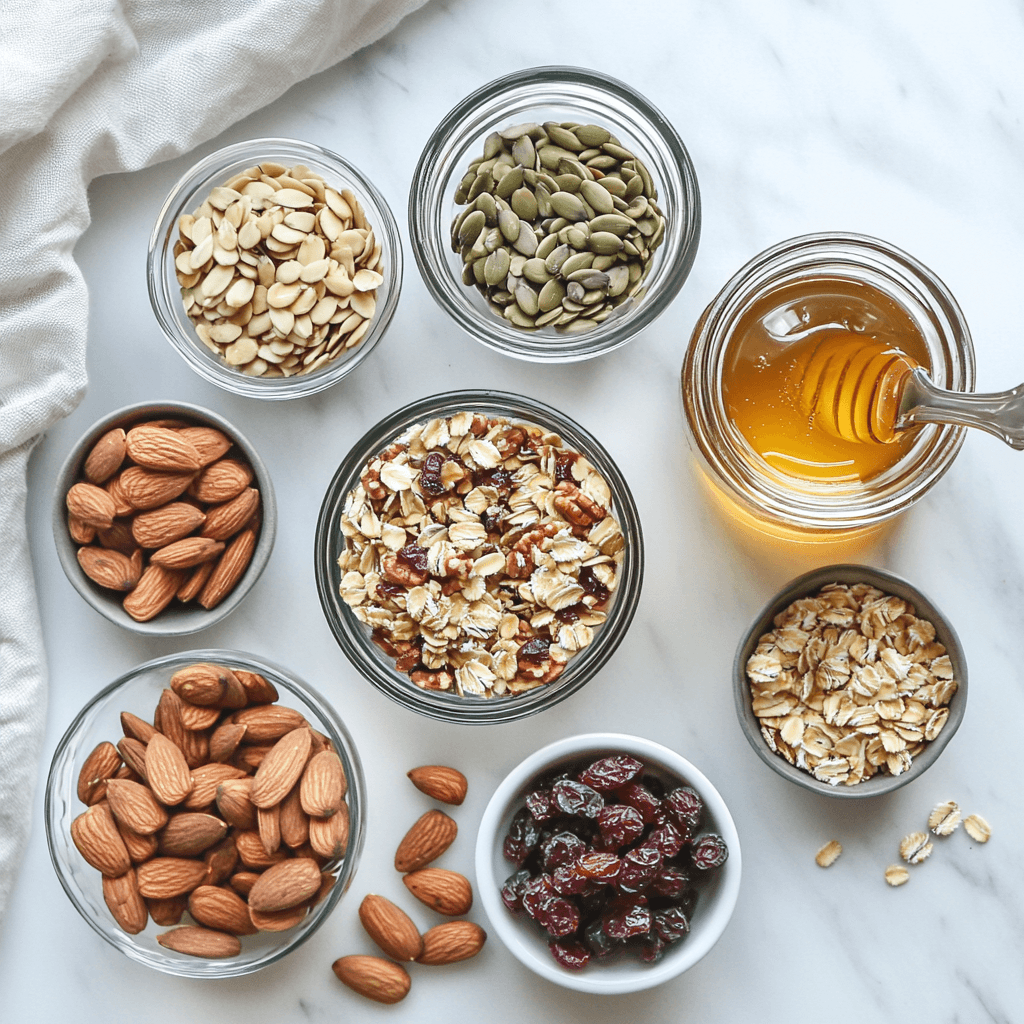
Certified Gluten-Free Oats
The cornerstone of gluten-free granola is certified gluten-free oats. While oats are naturally gluten-free, they are often cross-contaminated with gluten-containing grains during harvesting, processing, or packaging. Certified gluten-free oats are carefully processed to eliminate this risk, ensuring they are safe for individuals avoiding gluten.
Oats provide a hearty base for granola and are packed with nutrients, including:
- Fiber: Supports digestive health.
- Beta-glucans: Helps regulate cholesterol and blood sugar levels.
- Essential vitamins and minerals: Including manganese, phosphorus, and magnesium.
Nuts and Seeds
Nuts and seeds are essential components of gluten-free granola, offering crunch, flavor, and nutritional benefits. Popular options include:
- Almonds: Rich in healthy fats, vitamin E, and protein.
- Walnuts: Contain omega-3 fatty acids and antioxidants.
- Pumpkin seeds: Provide zinc, magnesium, and iron.
- Chia seeds: High in fiber and omega-3 fatty acids.
These ingredients enhance the granola’s texture and provide long-lasting energy.
Sweeteners: Natural and Wholesome
Gluten-free granola often relies on natural sweeteners to bind the ingredients and add flavor. Common options include:
- Honey: Offers natural sweetness and antibacterial properties.
- Maple syrup: A plant-based sweetener with a unique flavor profile.
- Coconut sugar: A lower-glycemic alternative to refined sugar.
Using natural sweeteners ensures that the granola is both delicious and health-conscious.
Dried Fruits and Flavor Enhancers
Dried fruits such as raisins, cranberries, apricots, and figs add natural sweetness and chewy texture. Additionally, flavor enhancers like vanilla extract, cinnamon, and cocoa powder elevate the taste while keeping the granola gluten-free.
Oils for Baking and Binding
Healthy oils are used to coat the ingredients before baking, ensuring a golden, crispy texture. Common choices include:
- Coconut oil: Adds a subtle tropical flavor.
- Olive oil: Provides a savory note and healthy fats.
- Avocado oil: Neutral in flavor and rich in nutrients.
By combining these ingredients, gluten-free granola achieves a perfect balance of taste, texture, and nutrition.
Health Benefits of Gluten-Free Granola
Gluten-free granola isn’t just a safe option for those with dietary restrictions; it also offers numerous health benefits that make it a valuable addition to anyone’s diet.
Digestive Health
Gluten-free granola is typically high in dietary fiber, particularly when it includes gluten-free oats, nuts, seeds, and dried fruits. Fiber plays a vital role in maintaining a healthy digestive system by:
- Promoting regular bowel movements.
- Feeding beneficial gut bacteria, improving gut microbiome health.
- Reducing the risk of constipation and other digestive issues.
For individuals with celiac disease or gluten sensitivity, gluten-free granola provides a gut-friendly option that avoids triggering adverse reactions.
Nutritional Value
Gluten-free granola is packed with essential nutrients that contribute to overall health:
- Protein: Found in nuts, seeds, and oats, helps repair tissues and maintain muscle mass.
- Healthy fats: Essential for brain health and reducing inflammation, provided by ingredients like almonds, walnuts, and coconut oil.
- Vitamins and minerals: Including magnesium, iron, zinc, and B vitamins, which support energy production and immune function.
The combination of these nutrients makes gluten-free granola a powerhouse for sustained energy and well-being.
Energy-Boosting Properties
The complex carbohydrates in gluten-free granola provide slow-releasing energy, making it an excellent choice for a nutritious breakfast or pre-workout snack. Unlike sugary cereals or snacks that cause a quick spike and crash in blood sugar, it offers a steady source of fuel throughout the day.
Weight Management and Satiety
Because it is rich in fiber, protein, and healthy fats, gluten-free granola is highly satisfying and helps curb hunger. Consuming it as part of a balanced diet can:
- Reduce overeating.
- Support weight management goals.
- Provide a sense of fullness for longer periods, helping to maintain energy levels between meals.
Heart Health
The beta-glucans in oats and healthy fats from nuts and seeds contribute to cardiovascular health. These components:
- Help lower LDL (bad) cholesterol.
- Reduce inflammation, a key factor in heart disease.
- Promote overall circulatory health.
By incorporating gluten-free granola into your diet, you can enjoy these heart-protective benefits in a convenient and delicious form.
Homemade vs. Store-Bought Gluten-Free Granola
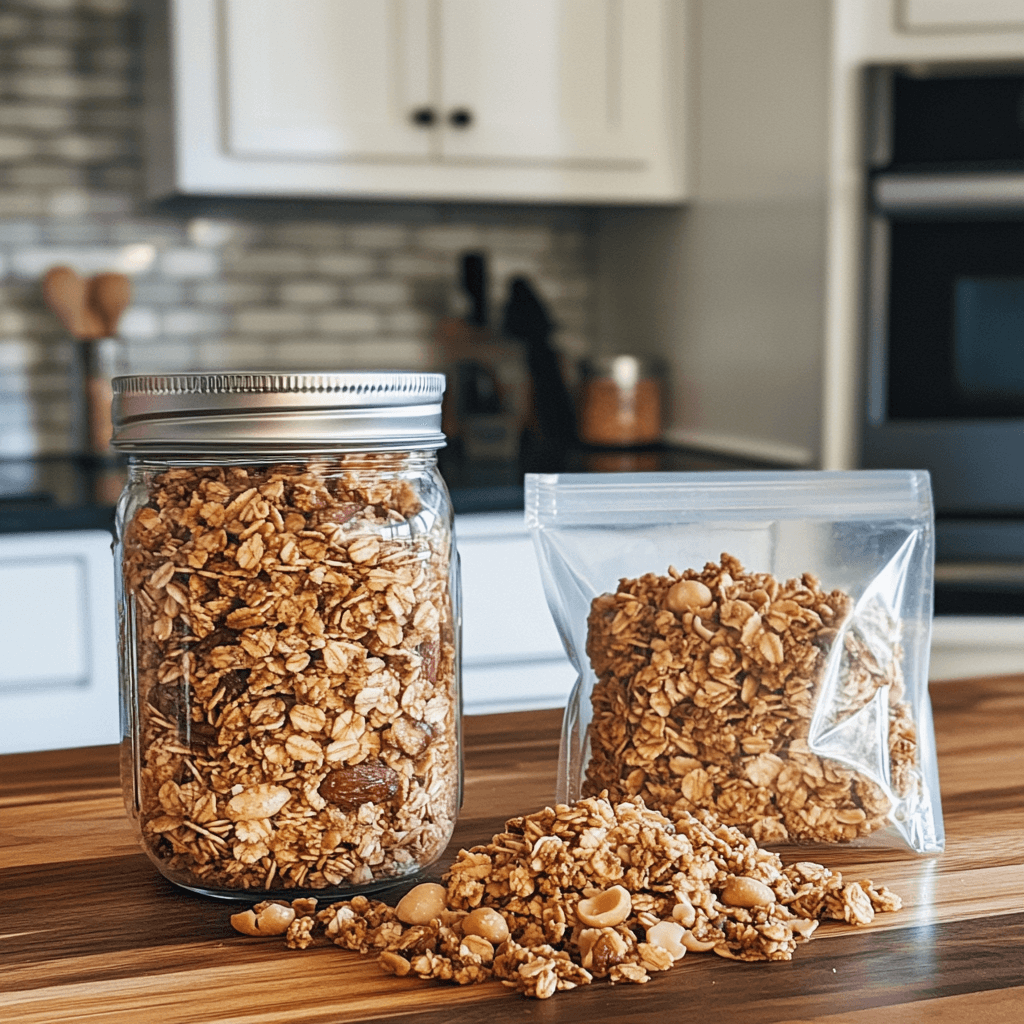
Choosing between homemade and store-bought gluten-free granola depends on factors like convenience, control over ingredients, and cost. Let’s compare the pros and cons of each.
Benefits of Making Your Own Gluten-Free Granola
1. Full Control Over Ingredients
When you make granola at home, you have complete control over the ingredients, ensuring everything is genuinely gluten-free. You can:
- Avoid hidden gluten sources.
- Customize flavors with your favorite nuts, seeds, sweeteners, and spices.
- Adjust sugar and fat levels to suit your dietary preferences.
2. Cost-Effective
Store-bought gluten-free granola can be expensive. Homemade versions are typically more affordable, especially when buying ingredients in bulk.
3. Freshness and Quality
Homemade granola is fresher than prepackaged options, and you can use high-quality, organic ingredients for maximum nutrition and taste.
4. Environmentally Friendly
By making granola at home, you can reduce waste by avoiding excessive packaging. Many ingredients can be purchased in reusable containers at bulk stores.
What to Look for in Store-Bought Gluten-Free Granola
If you prefer the convenience of store-bought granola, it’s important to choose wisely. Here’s what to consider:
1. Certified Gluten-Free Labeling
Ensure the granola is certified gluten-free. Look for labels from trusted certification programs like GFCO (Gluten-Free Certification Organization).
2. Transparent Ingredient Lists
Read the ingredient list carefully. Avoid products with:
- Unnecessary additives and preservatives.
- High sugar content or artificial sweeteners.
- Ingredients that could contain hidden gluten, such as malt extract or modified food starch.
3. Nutritional Value
Check the nutrition facts panel for balanced macronutrients. Aim for granola that is:
- High in fiber and protein.
- Low in added sugars and unhealthy fats.
4. Trusted Brands
Some reputable brands specializing in gluten-free products include Bob’s Red Mill, Purely Elizabeth, and KIND. These brands prioritize quality and transparency in their offerings.
Convenience vs. Customization
Homemade granola is ideal for those who enjoy cooking and want to experiment with flavors, while store-bought options cater to busy individuals seeking a quick and easy solution. Regardless of your choice, both options can be incorporated into a healthy, gluten-free lifestyle.
How to Make Gluten-Free Granola at Home
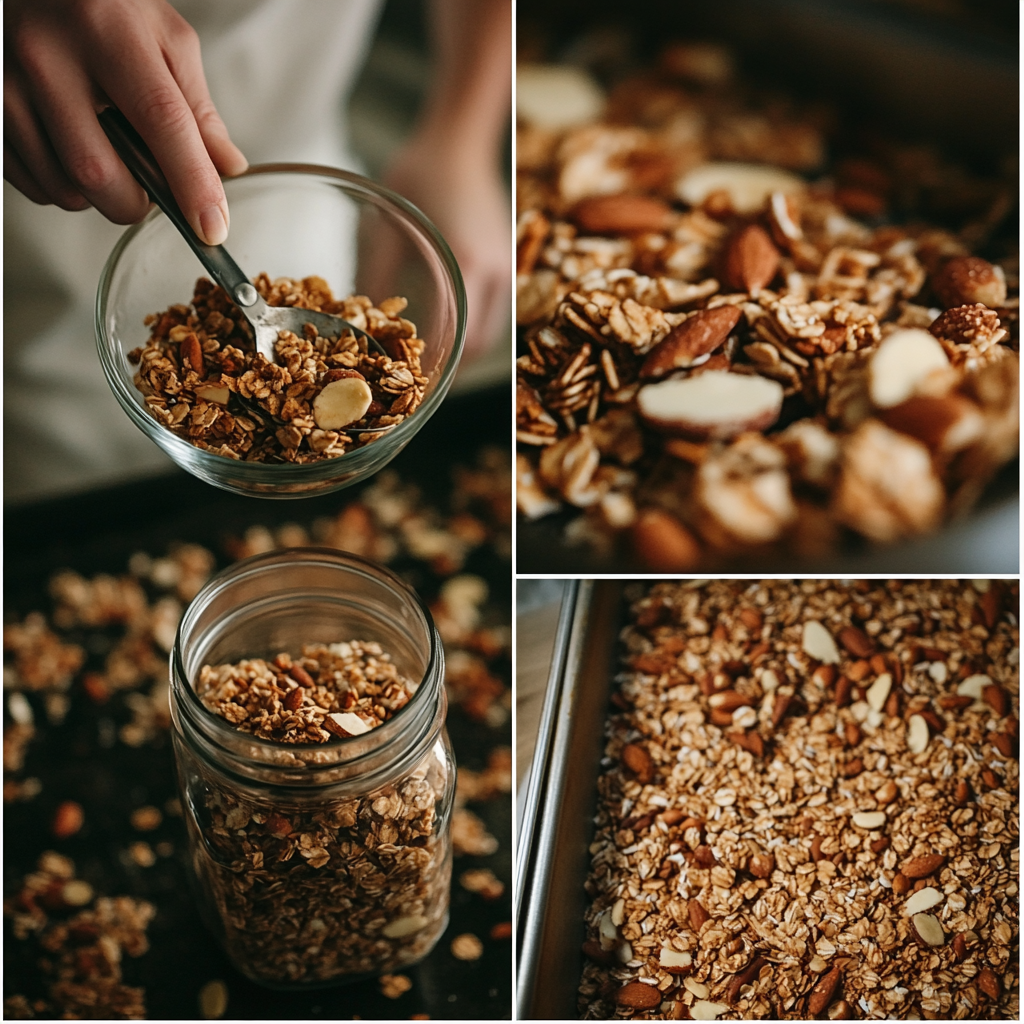
Making your own gluten-free granola is a fun and rewarding process that allows you to tailor the recipe to your preferences. Here’s a step-by-step guide to crafting the perfect homemade granola.
Step-by-Step Guide
1. Gather Your Ingredients
To make gluten-free granola, you’ll need the following base ingredients:
- Certified gluten-free oats: The foundation of your granola.
- Nuts and seeds: Almonds, walnuts, pumpkin seeds, sunflower seeds, etc.
- Dried fruits: Raisins, cranberries, chopped apricots, or dates.
- Sweeteners: Honey, maple syrup, or agave nectar.
- Oils: Coconut oil, olive oil, or avocado oil for binding and baking.
- Flavor enhancers: Vanilla extract, cinnamon, nutmeg, or cocoa powder.
2. Preheat the Oven
Set your oven to 325°F (160°C) to ensure even baking without burning the granola.
3. Mix the Dry Ingredients
In a large mixing bowl, combine your gluten-free oats, chopped nuts, seeds, and any spices you’re using. This forms the base of your granola.
4. Prepare the Wet Ingredients
In a small saucepan, gently heat your chosen oil and sweetener (e.g., coconut oil and honey). Stir until combined, then add vanilla extract or other liquid flavorings.
5. Combine Everything
Pour the wet mixture over the dry ingredients, stirring thoroughly to coat everything evenly. The wet mixture ensures that your granola binds and develops a crisp texture.
6. Bake to Perfection
Spread the granola mixture onto a baking sheet lined with parchment paper. Bake for 20-30 minutes, stirring every 10 minutes to ensure even browning. Watch closely during the final minutes to prevent burning.
7. Add Dried Fruits
Once baked, let the granola cool completely. Stir in dried fruits of your choice. Adding them after baking preserves their chewy texture and prevents burning.
8. Store Your Granola
Store the granola in an airtight container at room temperature for up to two weeks or in the freezer for longer freshness.
Best Combinations of Ingredients
Experiment with unique combinations to create flavorful gluten-free granola blends. Here are some ideas:
- Classic Nutty Mix: Almonds, walnuts, and a touch of cinnamon.
- Tropical Delight: Coconut flakes, dried pineapple, and macadamia nuts.
- Berry Bliss: Dried cranberries, blueberries, and a hint of vanilla.
- Chocolate Crunch: Cocoa powder, chocolate chips (added after baking), and hazelnuts.
Tips for Perfect Granola Every Time
- Avoid overcrowding the baking sheet: This ensures even browning.
- Don’t skip the stirring: Mixing during baking prevents clumping and burning.
- Adjust sweetness to taste: Add more or less sweetener depending on your preference.
Making gluten-free granola at home is simple and satisfying, offering endless possibilities to match your dietary needs and flavor preferences.
Savoring the Best Gluten-Free Granola
Making gluten-free granola at home is a wonderful way to enjoy a healthy, customizable, and delicious snack or breakfast option. Packed with wholesome ingredients like oats, nuts, and dried fruits, this granola pairs perfectly with yogurt or almond milk for a nutritious start to your day. To enhance your gluten-free culinary adventures, explore our tips on The Difference Between Old Bisquick and New Bisquick, which highlights more gluten-conscious choices. For another flavorful pairing, try the Salmon and Sweet Potato Recipe as a nutritious main course to complement your granola breakfast. Visit our Recipe Collection for even more inspiration and healthy, gluten-free ideas.
Frequently Asked Questions (FAQs)
Is all granola gluten-free?
No, not all granola is gluten-free. While oats, a primary ingredient in most granola recipes, are naturally gluten-free, they are frequently contaminated with gluten during processing. Moreover, some granola brands include ingredients like barley malt, wheat-based sweeteners, or other additives that contain gluten. Therefore, it is crucial to carefully read labels and choose granola that is certified gluten-free. Furthermore, opting for certified products ensures safety and eliminates the risk of hidden gluten, which can be problematic for those with gluten sensitivities. In this way, individuals can enjoy granola without compromising their dietary needs.
Can gluten-free granola help with weight loss?
Gluten-free granola can support weight loss when consumed as part of a balanced diet. Its high fiber content promotes satiety, helping to control hunger and prevent overeating. However, portion size is crucial, as granola is calorie-dense due to its nuts, seeds, and sweeteners. Opt for unsweetened or lightly sweetened versions to reduce calorie intake.
How can I avoid cross-contamination with gluten?
To avoid cross-contamination:
- Purchase certified gluten-free oats and other ingredients.
- Use clean utensils, bowls, and baking sheets that haven’t come into contact with gluten-containing foods.
- If buying store-bought granola, choose products from dedicated gluten-free facilities.
What is the shelf life of gluten-free granola?
Homemade gluten-free granola typically lasts up to two weeks when stored in an airtight container at room temperature. To extend its shelf life, freeze it in a sealed bag or container for up to three months. Store-bought granola often has a longer shelf life due to preservatives; check the packaging for exact dates.
Is gluten-free granola suitable for vegans?
Yes, most gluten-free granolas are vegan-friendly, especially if they use plant-based oils (like coconut or olive oil) and natural sweeteners (like maple syrup). However, some may contain honey or other non-vegan ingredients, so always check the label.
Can I eat gluten-free granola if I’m not gluten-intolerant?
Absolutely! Gluten-free granola is not only safe for those without gluten intolerance but also offers a nutritious and delicious alternative to traditional granola. Many gluten-free granolas use high-quality, minimally processed ingredients, making them a healthy choice for anyone.
Conclusion
Gluten-free granola is a versatile, nutritious, and delicious option for individuals with or without dietary restrictions. Whether you choose to make it at home or purchase it from trusted brands, this wholesome snack offers countless possibilities for breakfast, snacks, or desserts. Moreover, its versatility allows you to customize flavors, textures, and ingredients to suit your preferences. In fact, it can be enjoyed on its own, paired with yogurt, or sprinkled over smoothie bowls for a nutritious boost. Additionally, it serves as a perfect base for creative dessert recipes or healthy trail mixes. Ultimately, no matter how you enjoy it, gluten-free granola is a delicious and convenient addition to any meal plan. By understanding the ingredients, benefits, and best practices, you can confidently incorporate it into your daily routine for a satisfying and healthful experience.

